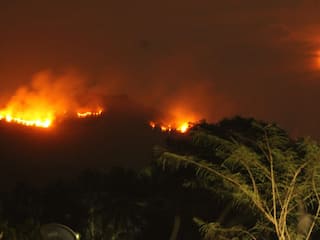What Is Mission Mausam? Modi Govt's Rs 2,000-Cr Project That Plans To Make India 'Climate-Smart'
Mission Mausam aims to enhance weather and climate forecasting capabilities with advanced technologies. The five-year initiative aims to expand observation networks and implement weather management techniques.

New Delhi: The Ministry of Earth Sciences (MoES) unveiled its ambitious five-year "Mission Mausam" project in New Delhi Friday. The initiative, endorsed by the Union Cabinet on September 11, 2024, with a budget allocation of Rs 2,000 crore over two years, aims to transform India into a "Weather-ready and Climate-smart" nation.
Dr. M Ravichandran, Secretary of MoES, was joined by Dr. Mritunjay Mohapatra, Director General of the India Meteorological Department (IMD), and Dr. V.S. Prasad, Head of the National Centre for Medium-Range Weather Forecasting (NCMRWF), to outline the project's goals and objectives.
Mission Mausam Unveiled: A 2,000 Crore initiative to Enhance India’s Weather and Climate Forecasting by 2026 @moesgoi organised a national-level media interaction on ‘Mission Mausam’ which was chaired by Secretary MoES on 12th Sep, 2024.#MissionMausam #PressBrief #Climate… pic.twitter.com/MQmUI7dLqr
— India Meteorological Department (@Indiametdept) September 13, 2024
What Is Mission Mausam And What Will It Do?
Mission Mausam is designed to significantly upgrade the country's capabilities in weather and climate forecasting. Its primary focus is to improve observational technologies and forecasting models, making them more accurate and timely, the ministry said in a statement. The mission aims to achieve this through the following key initiatives:
Advanced Surveillance Technologies: Development and implementation of next-generation radars, satellites, and high-performance computers (HPC) to enhance weather surveillance.
Enhanced Observation Networks: Installation of 50 Doppler Weather Radars (DWR), 60 Radio Sonde/Radio Wind (RS/RW) stations, 100 disdrometers, 10 Wind Profilers, and 25 radiometers across the country.
Innovative Weather Management Technologies: Integration of cutting-edge earth system models, data-driven AI/ML methods, and advanced dissemination systems for effective weather management.
Dr. Ravichandran highlighted that Mission Mausam would improve both spatial and temporal resolution of weather forecasts and air quality data. "By March 2026, we are looking at installing a wider network of radars, wind profilers, and radiometers for better observations. We also look forward to better understanding the physical processes and the science of weather forecasting. There will be improved data assimilation with increased ingestion of the observations. We will also fuse physics-based numerical models and data-driven AI/ML to improve the forecasts. We would witness more innovations, R&D and advancements in atmospheric sciences," he said.
ALSO READ | August 2024 Was The Hottest Summer On Record On This Earth, NASA Says
Mission Mausam And Cloud Seeding
Asked why weather management is needed, Dr. Ravichandran told PTI: "If it's raining continuously in Delhi, which could lead to flooding, can I suppress the rain? By seeding the clouds a little more, it may stop raining. Similarly, in a drought-prone area, this could help prevent droughts by enhancing rainfall."
Weather management techniques, particularly cloud seeding, are emerging as potential solutions for addressing extreme weather conditions. Cloud seeding involves dispersing substances such as silver iodide, potassium iodide, and dry ice (solid carbon dioxide) into clouds to encourage precipitation. This process helps water vapour condense around the particles, leading to increased rainfall or snowfall. The technique could be useful for mitigating flooding during heavy rains or enhancing rainfall in drought-prone areas.
Globally, cloud seeding has been utilised in countries like the US, China, Australia, and the UAE, where it has been applied to manage water scarcity and address drought conditions. Despite its use, the effectiveness and environmental impact of cloud seeding remain under study.
Quoting an India Meteorological Department (IMD) official, the PTI report said there have been a few cloud seeding trials in India, including in Telangana, Tamil Nadu, and Karnataka, but these efforts have yielded limited results so far. The IMD notes that ongoing research is necessary to better understand the technique’s efficacy and environmental consequences.
The Delhi government also considered using cloud seeding to improve air quality during winter in collaboration with IIT-Kanpur. The goal was to induce rain to wash away pollutants. However, the project got delayed because it required permissions from several Central government agencies, including aviation and environmental authorities.
ALSO READ ON ABP LIVE | August 2024 Was The Hottest Summer On Record On This Earth, NASA Says
Future Goals Of Mission Mausam
Ravichandran told PTI the five-year Mission Mausam would be implemented in two phases. The first phase will run until March 2026, and it will focus on expansion of the observation network. During this phase, around 70 Doppler radars and high-performance computers would be added, and 10 wind profilers and 10 radiometers set up.
According to the report, the IMD has so far installed 39 Doppler radars, and no wind profiler was ever set up. In contrast, there are 217 radars and 128 wind profilers in China, and 160 radars and 100 wind profilers in the US.
In the second phase, the report said, the mission will focus on adding satellites and aircraft for increased observational capabilities.
The mission also aims to bolster the resilience of communities against climate change and extreme weather events, according to the ministry. By improving data dissemination and building capacity across various sectors, Mission Mausam intends to ensure no weather system goes undetected. The initiative will benefit citizens and stakeholders by providing enhanced services for weather, climate, and natural hazards.
Three key institutes — IMD, NCMRWF, and the Indian Institute of Tropical Meteorology — will spearhead the mission, supported by other MoES institutions and collaborations with national and international entities.
Over the next five years, Mission Mausam will focus on improving short- to medium-range weather forecast accuracy by 5 to 10 percent and enhancing air quality prediction in major metro cities by up to 10 per cent, PTI reported. The mission will also enable accurate weather prediction down to the panchayat level up to 10-15 days in advance, and more frequent nowcasting, providing updates every hour rather than every three hours, the report said, adding that this will be crucial for tracking fast-changing weather events such as thunderstorms, heavy rain or snow, and improving overall weather management.






































